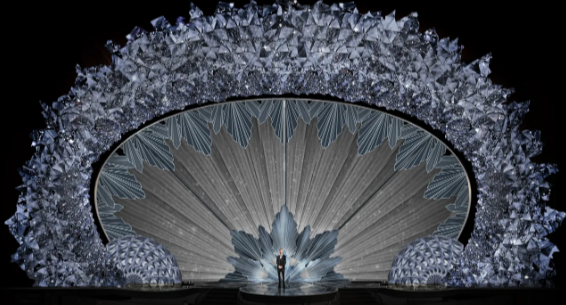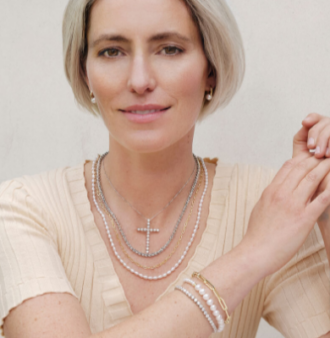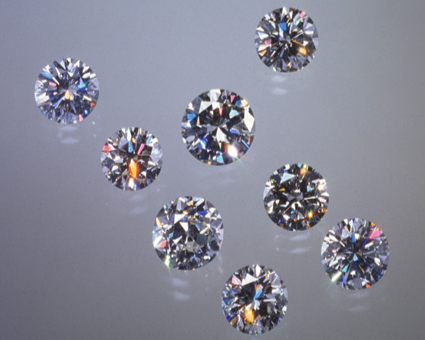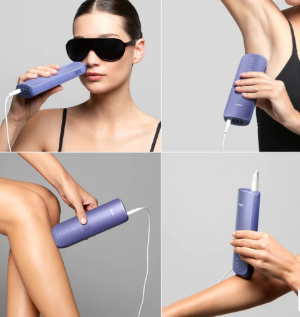The debate – Swarovski vs. diamond continues to puzzle many even in this 21st century. Unless one is well-versed with different gem characteristics, it’s difficult to tell the difference between Swarovski and diamond especially if the diamond is colored. It’s therefore easy to be fooled in the eye and end up buying a Swarovski ornament instead of a diamond and vice versa.
Even though it’s almost impossible to tell the difference between a Swarovski crystal and a diamond, they’re different in many aspects. While a diamond is mined, Swarovski is chemically grown in laboratories and coated with chemicals to bring out stunning clarity with many beautiful colors. Another difference is diamonds have a higher price tag compared to Swarovski.
In this article, we’ll take you to the beautiful land of Swarovski company and later help you know the differences between Swarovski and diamond. In the summary table, you’ll find their refractive index difference, hardness, fracture, and price tag differences.
Here’s what you’ll learn about Swarovski and diamonds.
Table of Contents:
- Part 1: Swarovski vs. Diamond: Brief History
- Part 2: Swarovski vs. Diamond: Differentiation Chart
- Part 3: Swarovski vs. Diamond: Price Differences
- Part 4: Swarovski vs. Diamond: Refractive index Differences
- Part 5: Swarovski vs. Diamond: Hardness Differences
- Part 6: Swarovski vs. Diamond: Rarity
- Part 7: Conclusion
Swarovski vs. Diamond: Brief History
Swarovski has redefined its perfection in making multicolored Swarovski crystals. Whether it’s home decor, ornaments, a Disney-inspired collection, or nature-inspired decorations for your home and office, Swarovski has the best Swarovski crystal for you.

To ignite your glamour with an all-around gold-tone necklace, clip earrings, or chain bracelet, Swarovski is the place to visit. In 1895, the Swarovski, a jewelry company was founded by Daniel in Austria. With unmatched craftsmanship and creativity, Swarovski manufactures and designs high-quality crystals such as the Swarovski crystals and even genuine gemstones.
As of today, the Swarovski crystal business sells its finely designed jewelry, home decor, watches, and accessories in 170 countries. Surprisingly, you’ll find some of these bold layered jewelry made from created stones. From the lined-up birthstones, the company’s perfection in making a shade of expression for every month is well articulated.
Swarovski offers a wide variety of products. They include gift items such as weddings, birthdays, and romantic gifts, decorations some inspired by nature and others by characters, symbols, and events, and accessories for smartphones, hair, and body. Other products Swarovski sells are jewelry and watches.
As the name suggests, the Swarovski company produces the Swarovski crystals which have a diamond resemblance. How and the components used have remained a big secret for the company. The first Swarovski crystals were made during the company’s inception in 1985.
Today you’ll find Swarovski crystals on dresses, jewelry, theatre displays, and fashion runway, and on stages as witnessed during the 2018 Oscar’s ceremony in which 45 million Swarovski crystals were used to design the elaborate stage.

After a series of improvements to the Swarovski crystals, the company developed metallic chemical coatings. Fancy multicolored jewelry and stylish watches with dazzling crystals became the norm since the introduction of chemical coatings in 1955.
Swarovski and diamond are two worlds apart. While Swarovski is renowned for making Swarovski crystals, a diamond is a gem mined from the earth.
Hair Removal With Sapphire Air3 Before Wearing a Necklace and Chain
Would you imagine the pain when your hair gets pulled? If you’ve got long hair on the arms or around the neck, we recommend a nearly painless hair removal to avoid hair pulling and also allow the pop of colors characterizing the Idyllia cocktail ring.
Say no to hair pulling by removing all the unwanted hair on your legs, arms, and face. Shaving with Sapphire Air3 IPL device is practically nearly painless and cool unlike using a razor, epilator, and waxing. Using this device to remove the unwanted hair around the neck and on the arms consistently for only 3 weeks will stop the hair from regrowing (* refers to a decrease in hair count within 3 weeks, sourced from third-party laboratory testing reports. Individual results may vary).
It’s also fast to use and has a shaving mode designed to effectively remove hair from every part of the body.
Swarovski vs. Diamond: Differentiation Chart
If you still cannot differentiate between a Swarovski crystal and a diamond, this chart is for you. But even before going into the nitty gritty of these two elements, pricing and rarity are two characteristics that should tell you the difference.
| Parameters | Swarovski Crystal | Diamond |
| Discovery |
Swarovski crystals were invented in 1895 by Daniel Swarovski who is also the founder of Swarovski company. As luxurious crystals, Swarovski crystals are now synonymous with high-end fashion and sophisticated designs.
At first, Swarovski used lead tetroxide and other chemicals to make its crystals but from 2012, they eliminated lead elements and today all Swarovski crystals are lead-free. |
Diamond is believed to have been discovered in India around 4000 years ago in caves. Diamond deposits are found on land and come from the earth’s mantle after carbon atoms are bounded symmetrically under high temperatures.
Diamonds are made of pure carbon atoms and are regarded as among the purest gems. |
| Core Characteristics | At the core of this crystal are its high refractive index and the allure of assorted Swarovski birthstone colors that inspire and give clarity with their radiating light. |
Diamonds have exceptional hardness and magnificent brilliance when cut and polished almost resembling the Swarovski crystal brightness.
Besides diamond being purely carbon, it’s also a natural substance. The impurities and structural defects are the source of colorations in gem diamonds. |
| Fun Facts |
Swarovski crystals aren’t crystals but are a type of glass made with a patented process and their structure is designed to imitate real diamond symmetry.
For many years, Swarovski crystals have been believed to have healing properties, especially green crystals. |
The largest diamond (Eureka Diamond) to be found was discovered by a 15-year-old boy in South Africa.
Diamonds exist in many different colors besides the colorless ones. Diamond is the hardest natural substance on earth. |
| Reputation | Swarovski crystals are renowned for their precision-cut facets, stunning clarity, and high quality. | Polished diamonds are renowned for their surface irregularities, unmatched brilliance, and extreme hardness. |
From the above Swarovski vs diamond chart, you’ll notice that Swarovski crystals do not exhibit the rarity of a gem like a diamond. Swarovski products are common and sold everywhere meaning they aren’t expensive. While you’ll find small accents of diamond on what many call “diamond jewelry”, Swarovski jewelry is majorly made of crystals.
Swarovski vs. Diamond: Price Differences
 Looking at the Swarovski prices explained in Swarovski vs Pandora, even the lowest-level earners can afford a piece of Swarovski jewelry or a Swarovski watch. After spending hours of research, the cheapest diamond jewelry carried a $920 price tag, which is over 100x the price of a piece of Swarovski jewelry.
Looking at the Swarovski prices explained in Swarovski vs Pandora, even the lowest-level earners can afford a piece of Swarovski jewelry or a Swarovski watch. After spending hours of research, the cheapest diamond jewelry carried a $920 price tag, which is over 100x the price of a piece of Swarovski jewelry.
At Swarovski, a piece of a ring will cost you between $20 and $50 while a diamond ring will cost a whopping $920 up to $32,420. Again, a Swarovski necklace will cost you between $63- $127 at Amazon, but to get a diamond necklace, prepare to part with $510 up to $46,000 at Blue Nile.com.
In terms of pricing per carat, 1 carat of Swarovski will cost an average of $15. On the contrary, 1 carat of diamond costs between $2,300 and $14,500.
Swarovski vs. Diamond: Refractive index Differences
 Refractive index or index of refraction is the measure of the bending of light rays when passing from one medium to another. Crystals and gems have different refractive indexes.
Refractive index or index of refraction is the measure of the bending of light rays when passing from one medium to another. Crystals and gems have different refractive indexes.
Swarovski crystals have a poor refractive index and score an average of 1.5 rating. On the other hand, the diamond has an exceptionally high refractive index of 2.42.
Swarovski vs. Diamond: Hardness Differences
Gemstone’s durability or hardness is measured in Mohs. The Mohs Hardness Scale is the mineral’s resistance to scratching.
Swarovski crystals on the Mohs Hardness Scale measure between 6 -7. This explains why they are susceptible to scratching even though not that easily. This differs from diamond hardness. On a Mohs scale of 1 to 10, diamond measures the highest -10. Without a doubt, a diamond is the hardest gemstone and is hard to scratch.
Diamonds don’t crack easily unless subjected to powerful blows, unlike crystals. In normal wear and tear, diamonds just chip and fracture.
Swarovski vs. Diamond: Rarity
Among the rarest gems in the world is the diamond. There are many other rare minerals but comparing Swarovski vs. diamond, the latter is rare.
While Swarovski crystals are chemically created in laboratories, real diamond is natural and hard to find whether through mining or surface searching. This explains the rarity difference between the two. Don’t be fooled by the availability of lab-grown diamonds which are plenty both online and in brick-and-mortar stores.
Conclusion
To tell the differences between Swarovski and diamonds, compare the appearances on their surface. A Swarovski crystal is likely to feel smoother compared to a diamond which is a little bumpy. After continued use of the two elements, you’ll find a diamond is more durable and resistant to scratches.

 By myulikeadmin
By myulikeadmin




